CSI Final part II
1/51
There's no tags or description
Looks like no tags are added yet.
Name | Mastery | Learn | Test | Matching | Spaced |
|---|
No study sessions yet.
52 Terms
Your goal as a CSI is to prevent the 3 main types of scene integrity issues…
1. Addition of material to scene
2. Destruction of material on scene
3. Movement of material on scene
The six crime scene activities and their basic order are…
Assessing, Observing, Documenting, Searching, Collecting, and Analyzing
Which of the six crime scene activities does this describe? “Assessment of the scene assists the investigator in deciding on what to do, when to do it, and what resources may be required. Assessment must be accomplished before taking any action, but assessment is an on-going activity as well. The investigator is constantly assessing the scene throughout processing.”
Assessing
1. Scope and complexity of the scene
2. Scene integrity and contamination control
3. Team approach and composition
4. Search methods to be used
5. Personal protective measures & safety hazards
Five Issues of Assessment
Assessment by the crime scene team always involves a debriefing of the ____ ______.
Initial responders
What involves two barriers which creates three areas of access? …
◦ Inner Scene: This is the actual crime scene, where only authorized investigators and crime scene technicians operate.
◦ Working Area: This is an area surrounding the inner scene, where other support police may enter,
equipment is staged and evidence is brought to.
◦ Outer Area: This is everything on the outside of the second barrier, where on-lookers, media and others may gather.
Multi-level containment
Photography teams work best with how many individuals?
Two
Sketch teams work best with how many individuals?
Three
Evidence Collection teams work best with how many individuals?
Two
Search teams are a matter of circumstance, but always require a minimum of how many individuals?
Two
What is the area that any given searcher is viewing at any given moment in the
search?
How tight or how broad this _______ will be is a product of several considerations:
◦ Nature of the ground being searched.
◦ Lighting considerations.
◦ On-scene environmental conditions.
◦ Size of the item being searched for.
Swathe size
List all of the basic crime scene search patterns…
Circle search, Wheel/Ray, Strip or line search, Grid search, Zone search, Point to point search
Excellent pattern in most interior or confined exterior scenes. Not effective in large exterior scenes or cluttered areas that impact on the circular movement.
Searcher moves inward or outward from a starting point.
Circle or spiral search
Searching begins in the middle, then searcher work their way out in a straight path.
May add in more searchers as the area becomes wider. May be coupled with additional searches like line searches.
Wheel/ray search
Best performed with 1-2 searchers. Excellent in exterior scenes where a large area
must be examined. Visual alignment to the strip is good for most situations, but as the area to be searched grows, it becomes more difficult to maintain a visual reference of the lanes. Physically laying out the strips with string or tape can help maintain the order.
Strip search
This search is another variation on the strip search. Searchers follows strips in one direction, then cuts across the scene in another set of strips, oriented 90 degrees to the first. Provides for multiple views of the same ground by the same searcher from different perspectives.
Grid search
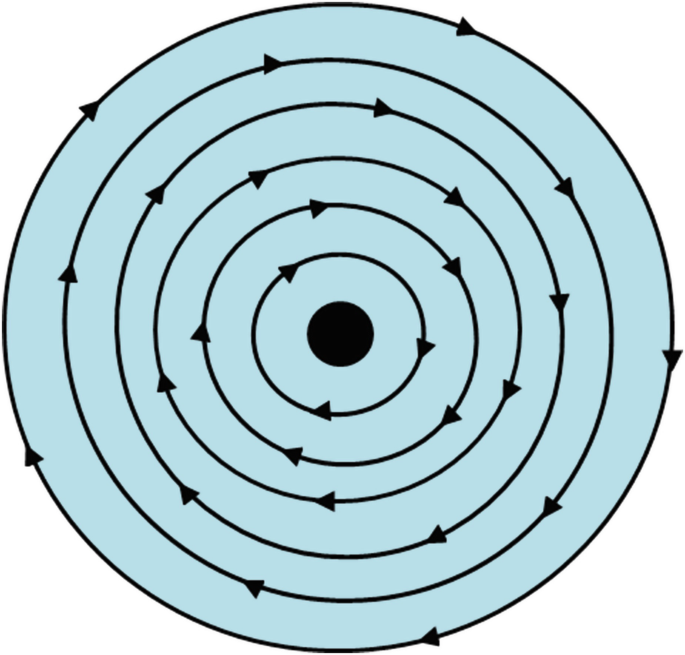
What is this search method?
Circle/spiral search
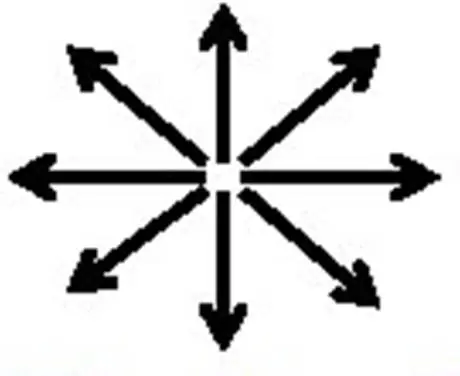
What is this search method?
Wheel/ray search
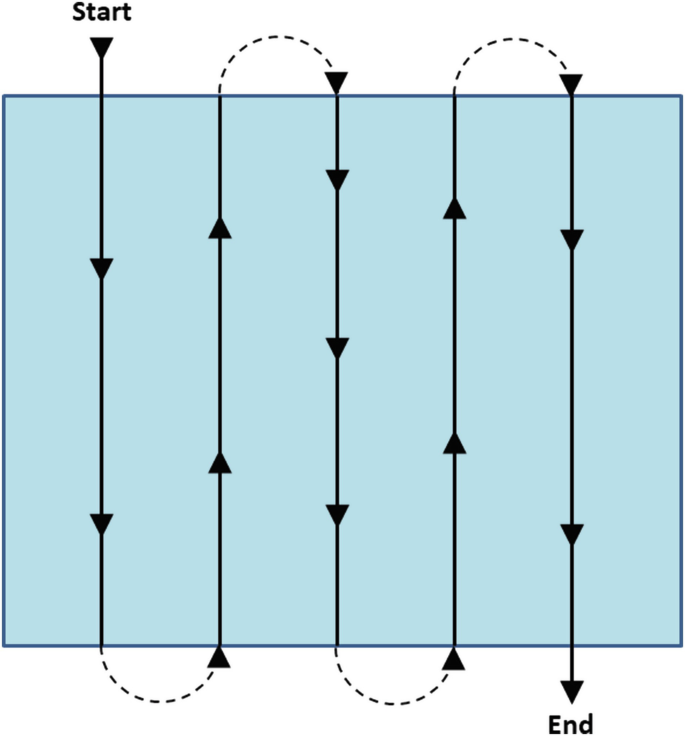
What is this search method?
Strip search
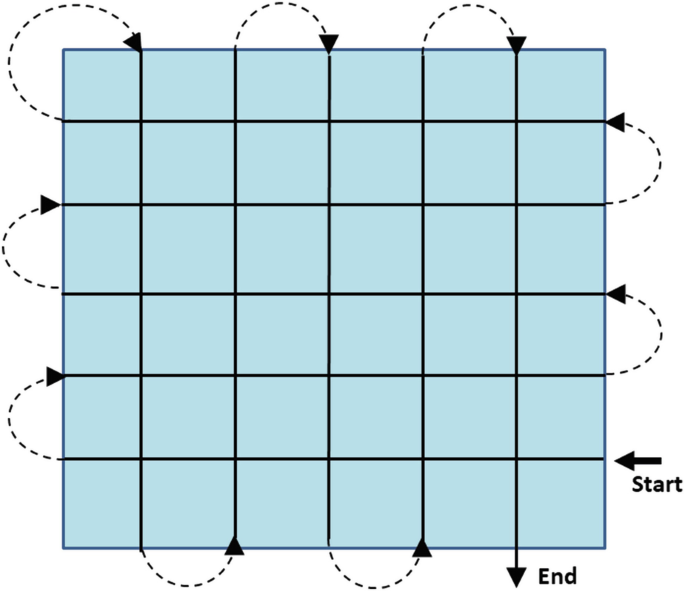
What is this search method?
Grid search
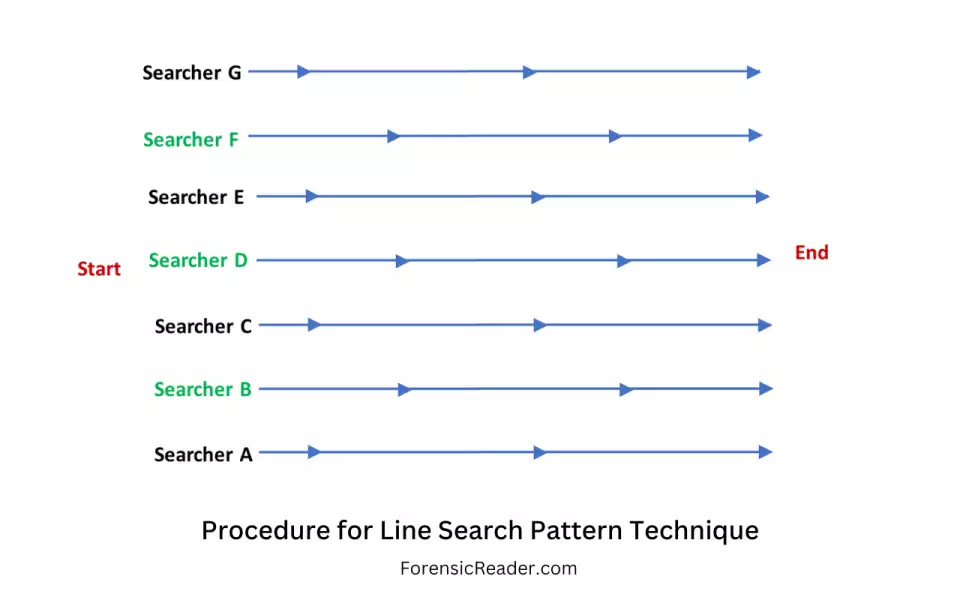
What is this search method?
Line search
This method is a variation of the strip search, where multiple searchers follow a single strip in one direction, while on-line with each other. Excellent for exterior scenes over rough terrain. Usually requires supervisor(s) to maintain the
direction and alignment of the involved searchers.
Line search
This search method is used in several variations: To deal with small confined spaces where no patterned search will work. To break a larger scene up into functional areas, that are then searched using some other patterned technique.
Zone search
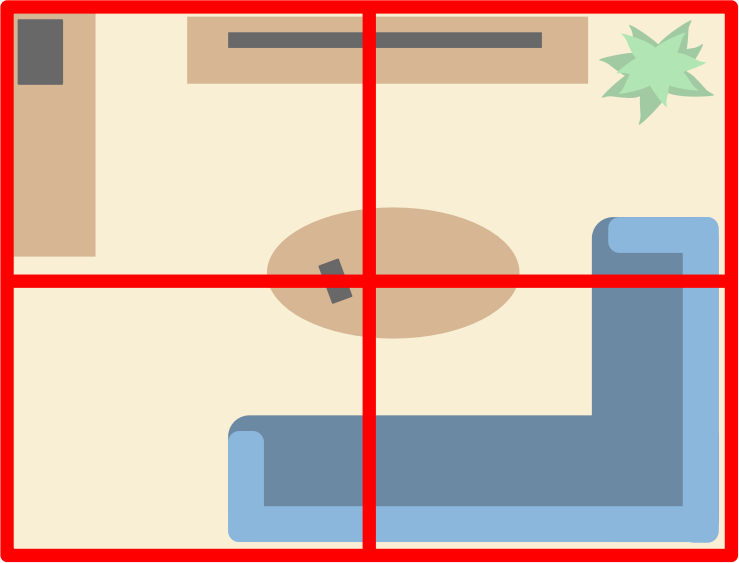
What is this search method?
Zone search
This search method is not widely used in the United States. Searchers move from one focal point to the next, creating cleared pathways to and from each. They do not stray from these pathways. Each focal point is dealt with before moving on to the next.
Point to point search
What are the different parts of the documenting stage for CSI?
Notes, photos/videos, sketches/laser scans, and reports
◦ Clearly show the layout of a crime scene – 2D
◦ Illustrate the relationship in space of all significant items and features
◦ Clarify objects and features already described in notes or shown in photographs
◦ Show measurements over long distances and topography of outdoor scenes
◦ Depict possible paths of entry, exit, and movement through the scene
Sketches
The standard crime scene sketch is drawn as a “_____” view
Birds-eye
What are the five essential elements of a sketch?
Heading, diagram area, legend, title block, and scale/direction notations
What type of sketch is an overhead view from above. Easily demonstrates items in a horizontal plane (e.g. floors, beds). Most common type of sketch.
Overview/birds-eye
What type of sketch portrays a vertical plane rather than horizontal plane (walls). Used to show details for bullet holes, bloodstains, etc. Drawn in a “side” view.
Elevation
What type of sketch shows walls/ceiling flat as if “exploded”. Used to show details/spatial relationship on walls/ceiling
Exploded/Cross-Projection
_______ are used for items that you are going to COLLECT. Make sure the numbers correspond with the photographs, notes, reports.
_______ are used to indicate something important but you are NOT going to collect
◦ Bullet holes
◦ Damage to areas
◦ Burn marks
Numbers, letters
Best utilized in exterior scenes with limited landmarks, but can be used indoors
This mapping technique is extended from a datum point in a cardinal direction. A single measurement is made from the evidence to the baseline at a right angle. Can use a tape measure between two “fixed points”.
How-To:
◦ Baseline created from a datum point.
◦ Evidence measured at right angles to the baseline.
◦ Two measurements required
◦ Distance 90 from tape to item
◦ Distance from 0”
Baseline mapping
◦ Take a GPS reading
◦ Drive a metal stake
◦ Place zero end of tape measure above metal stake
◦ Run tape measure along magnetic north using a compass
What to do if there are no fixed points for baseline mapping
This mapping technique is best utilized in interior scenes with clear, rectangular boundaries. Two measurements are made from the evidence to the surrounding walls and surfaces, at right angles. Best used to document items on a VERTICAL surface – walls/windows/doors
How-To:
◦ Evidence measured from center of mass
◦ To surrounding walls at right angles
◦ Two measurements required
Rectangular mapping
This mapping method is the most common used measurement tool. Best utilized in scenes with evident landmarks (indoors and outdoors). The most precise mapping method as it fixes regular shaped objects in a specific position. It is time intensive due to the measurements required. The number of measurements is based on whether the objects shape is regular or irregular.
How-To:
◦ Measure from 1st fixed point to item then;
◦ Measure from 2nd fixed point to item
◦ Measure distance BETWEEN TWO FIXED POINTS (Reference points)
Triangulation mapping
Irregular shaped objects require ____ straight line measurements from two distinct landmarks in the room to the center of mass on the item.
Two
Regular shaped objects require a total of ____ straight line measurements from two distinct landmarks in the room to two distinct points on the item.
Four
Best utilized in exterior scenes where evidence is scattered over a relatively open area. Requires a surveying instrument (e.g. compass, laser or sighting transit).
Angle from datum point to the evidence is determined with the device (horizontal angle). Distance from datum to the evidence is measured.
How-To:
◦ Angle to the evidence measured from a datum.
◦ Horizontal distance to the evidence measured.
◦ One measurement, one angle per item.
Polar coordinate mapping
Both _____ coordinates and _____ can be used on a grid.
Rectangular, triangulation
What does CAD stand for? —> Helps create final sketches
Computer-aided drafting
Crime scene photography has four recurring problems that detract from its value. These are…
Identification, orientation, confusion, and incomplete documentation Issues
In crime scene photography, ______ issues involve creating photographs where the viewer is lost in the scene. Photographs are taken of items and the photo fails to illustrate what it is in the picture or the photo documentation fails to illustrate why the photograph was taken in the first place.
Identification
In crime scene photography, ______ issues involve creating photographs where the viewer is lost in the scene or has no orientation. Photographs are taken of an object with no scene reference (e.g. Where is it in the scene). Photographs are taken in which orientation is not clear (e.g Which way is up?)
Orientation
In crime scene photography, ______ issues occur when the crime scene team fails to capture pertinent scene details. Too few photographs are exposed. Critical areas of the scene are forgotten. Methodical scene processing techniques help eliminate this issue.
Incomplete documentation
In crime scene photography, ______ issues involve creating photographs where the viewer is unclear of which item is being photographed or which photo came first. Photographs show the scene in altered states. Photographs show multiple similar items with no way to distinguish one from the other. This is particularly true when photographing small objects like shell casings and bloodstains.
Confusion
What are the three cardinal rules of photography?
Fill the frame 2. Maximize depth of field 3. Keep the film plane parallel
What are the unofficial other two rules of crime scene photography?
NEVER delete photographs off of the camera and NEVER have people in your photographs
These types of photographs document the general conditions of the scene. Shows how the scene relates to the surrounding area. Used to establish more detailed photos
Interior & Exterior
◦ “As is” (without evidence markers)
◦ With evidence markers
Taken from a “Natural Perspective”
◦ Eye level
Overall
These types of photos are functioned to frame the item of evidence with an easily recognized landmark (Fixed Point). This visually establishes the position of the evidence in the scene. They are the most overlooked photograph in crime scene work. The evidence establishing photograph is not intended to show details, simply to frame the item with a known landmark in the scene. The close-up and the evidence establishing photograph go hand in hand.
Midrange
These types of photos are functioned to allow the viewer to see all evident detail on the item of evidence. Not concerned about the context or relationship, only the subject, with and without scale. You must get close and fill the frame with the evidence ONLY. They are taken with and without a scale. Very important when taking photos of small items, whose detail may affect another analysis. Ensure a good focus, make the picture sharp.